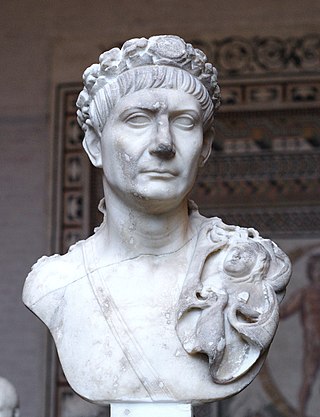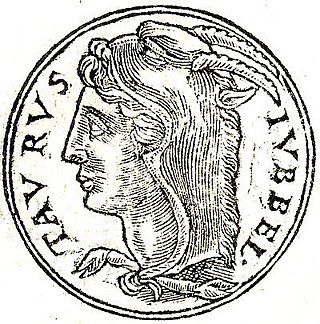Related Research Articles

Lucius Septimius Severus was a Roman politician who served as emperor from 193 to 211. He was born in Leptis Magna in the Roman province of Africa. As a young man he advanced through the customary succession of offices under the reigns of Marcus Aurelius and Commodus. Severus was the final contender to seize power after the death of the emperor Pertinax in 193 during the Year of the Five Emperors.

Decimus Clodius Albinus was a Roman imperial pretender between 193 and 197. He was proclaimed emperor by the legions in Britain and Hispania after the murder of Pertinax in 193. Initially Albinus cooperated with another contender for the throne, Septimius Severus, but the two turned on each other in 196 and commenced a civil war. Albinus died in battle the following year.

Legio XIV Gemina was a legion of the Imperial Roman army, levied by Julius Caesar in 57 BC. The cognomen Gemina (Twinned) was added when the legion was combined with another understrength legion after the Battle of Actium. The cognomen Martia Victrix was added following their service in the Pannonian War c. AD 9 and the defeat of Boudicca in AD 61. The emblem of the legion was the Capricorn, as with many of the legions levied by Caesar.

Legio I Italica was a legion of the Imperial Roman army founded by emperor Nero on September 22, 66. Originally named Legio Phalanx Alexandri Magni, it was stationed in Italy during the year of four emperors and gained the name Italica. It was later stationed at Novae, near modern-day Svishtov (Bulgaria). There are still records of the I Italica on the Danube border at the beginning of the 5th century. The emblem of the legion was a boar.

Legio I Minervia was a legion of the Imperial Roman army founded in AD 82 by emperor Domitian, for his campaign against the Germanic tribe of the Chatti. Its cognomen refers to the goddess Minerva, the legion's protector. There are still records of the I Minervia in the Rhine border region in the middle of the 4th century. The legion's emblem is an image of goddess Minerva.

Legio I Adiutrix, was a legion of the Imperial Roman army founded in AD 68, possibly by Galba when he rebelled against emperor Nero. The last record mentioning the Adiutrix is in 344, when it was stationed at Brigetio, in the Roman province of Pannonia. The emblem of the legion was a capricorn, used along with the winged horse Pegasus, on the helmets the symbol used by I Adiutrix legionaries was a dolphin.
Lucius Marius Maximus Perpetuus Aurelianus was a Roman biographer, writing in Latin, who in the early decades of the 3rd century AD wrote a series of biographies of twelve Emperors, imitating and continuing Suetonius. Marius's work is lost, but it was still being read in the late 4th century and was used as a source by writers of that era, notably the author of the Historia Augusta. The nature and reliability of Marius's work, and the extent to which the earlier part of the HA draws upon it, are two vexed questions among the many problems that the HA continues to pose for students of Roman history and literature.
Cornelius Repentinus was a Roman Senator who was active in the 2nd century AD. He held a number of positions during the reigns of emperors Marcus Aurelius, Commodus and Didius Julianus, which included suffect consul and Urban prefect of Rome.
Publius Septimius Geta was the second son to the elder Publius Septimius Geta and brother of the emperor Septimius Severus. His mother was Fulvia Pia. He was born and raised in Leptis Magna. He had Italian Roman ancestry on his mother's side, and was descended from Punic forebears on his father's side.
Quintus Anicius Faustus was a Roman military officer and senator who was appointed suffect consul in AD 198.
Lucius Valerius Messalla Thrasea Priscus was a Roman senator active during the reigns of Commodus and Septimus Severus.

The gens Ulpia was a Roman family that rose to prominence during the first century AD. The gens is best known from the emperor Marcus Ulpius Trajanus, who reigned from AD 98 to 117. The Thirtieth Legion took its name, Ulpia, in his honor. The city of Serdica, modern day Sofia, was renamed as Ulpia Serdica.
Gaius Caesonius Macer Rufinianus was a Roman military officer and senator who was appointed suffect consul in around AD 197 or 198. He was the first member of gens Caesonia to hold a consulship.
Publius Martius Verus was a Roman senator and general. He was twice consul. Verus played a major role in the suppression of the revolt of Avidius Cassius by remaining loyal to the emperor Marcus Aurelius.
Gaius Popilius Carus Pedo was a Roman senator who held several offices in the emperor's service during the second century. He was suffect consul in succession to Tiberius Licinius Cassius Cassianus as colleague of Sextus Cocceius Severianus Honorinus until the end of 147.
Marcus Munatius Sulla Cerialis was a Roman senator, who was active during the early third century AD.

The gens Statilia was a plebeian family of Lucanian origin at ancient Rome. Members of this gens are first mentioned in the third century BC, when one of them led the Lucanian assault on the city of Thurii, and another commanded an allied cavalry troop during the Second Punic War; but at Rome the Statilii first come to attention in the time of Cicero, at which point they held equestrian rank. The first of the family to attain the consulship was Titus Statilius Taurus in 37 BC, and his descendants continued to fill the highest offices of the Roman state until the time of Marcus Aurelius.
Titus Aius Sanctus was a Roman eques, who held several important imperial appointments then was later promoted to senatorial rank. Sanctus was consul suffectus around 185.
Popilius Pedo Apronianus was a Roman senator, who was active during the reign of Septimius Severus. He was Roman consul in the year 191 with Marcus Valerius Bradua Mauricus as his colleague.
References
- ↑ Leunissen, Konsuln und Konsulare in der Zeit von Commodus bis Severus Alexander (Amsterdam: J.C. Gieben, 1989), p. 362
- 1 2 Birley, Septimius Severus, the African Emperor, revised edition (New Haven: Yale, 1989), p. 40
- ↑ Syme, "The Friend of Tacitus", Journal of Roman Studies , 47 (1957), p. 133
- ↑ CIL VI, 1408 = ILS 1141; CIL VI, 1409 = ILS 1142
- ↑ Richard Talbert, The Senate of Imperial Rome (Princeton: University Press, 1984), p. 16
- ↑ Leunissen, Konsuln und Konsulare, p. 304
- ↑ Leunissen, Konsuln und Konsulare, p. 323
- ↑ Leunissen (Konsuln und Konsulare, p. 326) provides the date; the Historia Augusta ("Commodus", xx.1) notes that he was consul designate in 193.
- ↑ Birley, Septimius Severus, p. 73
- ↑ Birley, Septimius Severus, p. 76
- ↑ Birley, Septimius Severus, p. 90
- ↑ Birley, Septimius Severus, p. 97
- ↑ Birley, Septimius Severus, p. 108
- ↑ Birley, Septimius Severus, p. 110
- ↑ Leunissen, Konsuln und Konsulare, p. 254
- ↑ Leunissen, Konsuln und Konsulare, p. 258
- ↑ Leunissen, Konsuln und Konsulare, p. 308
- ↑ Cassius Dio, Roman History, lxxix
- ↑ Samuel Ball Platner (as completed and revised by Thomas Ashby), "Gardens of Ancient Rome" and "Houses in the City of Rome", in A Topographical Dictionary of Ancient Rome, Oxford University Press, London, 1929. From Lacus Curtius.
- ↑ Cassius Dio, Roman History, lxxviii 4-5